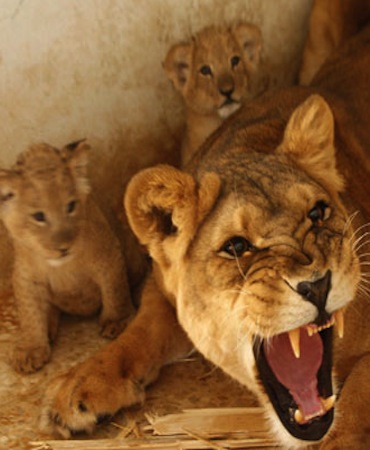

Females in the pride are usually related and have very strong bonds. Lions are very social animals and are the only big cat that lives in prides. For instance, the lions of the Kalahari are renowned for their very black manes and the lions of Namibia have longer legs and leaner bodies for endurance as they need to travel some distance looking for prey in the desert conditions. Their colouring, and often size, adapts to their habitat. Their habitat is mainly woodland savannas, grasslands and semi-desert. Lion cubs are born with blue eyes which change colour at 2-3 months of age. Most hunting takes place between dusk and dawn. One reason is to allow more light into the eye at night for better night vision. Lions have round pupils, unlike the vertical ones of domestic cats. When you are in the bush and you hear a lion roar you actually feel that roar reverberating right through your body. The bigger and darker the mane, the more attractive he is to a lioness as a mate as this shows he will be more intimidating to rivals, thus protecting the cubs, and that he has good genes.Ī lion's roar can be heard up to 10 km away. They roar to communicate with other members of their pride or coalition and to warn off any intruders to their territory. A fully grown female lion weighs between 110 and 155 kg, with a shoulder height of about 1m and a total length of up to 2.75 m.Īdult male lions are the only big cat to have a mane. Their vocalisations also vary in intensity and pitch.Lions ( Panthera Leo) are an apex predator and the largest big cat in Africa. A fully grown male lion can weigh between 150 and 225 kg, with a shoulder height of around 1.2 m and a total length of up to 3.3 m. They also communicate through a variety of vocalisations including purrs, snarls, miaws and hissing. Head rubbing, or nuzzling, is a common greeting behaviour for lions. They will perform peaceful tactile actions such as licking each other and rubbing heads.
Lions communicate through a range of behaviors and their expressive movements are very highly developed. Two or more lionesses in a group tend to give birth around the same time, and the cubs are raised together. Lionesses are caring mothers who will even take care of a neglected cub, allowing him/her to suckle and giving them a chance to survive. This gives them a distinct advantage over some prey species when hunting at night. They are 6 times more sensitive to light than humans. They have few sweat glands so they wisely tend to conserve their energy by resting during the day and become more active at night when it is cooler. They spend between 16 and 20 hours each day resting and sleeping. Lions enjoy relaxing and lazing around. A lion’s heels don’t touch the ground when it walks.  A good gauge of a male lion’s age is the darkness of his mane. The expression may have come from an incorrect association between Africa and jungles or may refer to a less literal meaning of the word jungle. Even though the lion is sometimes referred to as the “king of the jungle,” it actually only lives in grasslands and plains. A lion can run for short distances at 50 mph and leap as far as 36 feet. A lion’s roar can be heard from as far as 5 miles away. Currently, there are approximately 350-400 lions in the park. The last remaining Asiatic lions are found in Sasan-Gir National Park in India, which was primarily created to protect the species. The lion was once found throughout Africa, Asia and Europe but now exists only in Africa with one exception. The lion is listed as vulnerable on the IUCN Red List of Threatened Species. These majestic cats are threatened by habitat loss. Male lions defend the pride’s territory while females do most of the hunting. African lions are the most social of big cats and only ones live together in groups or “prides.” A pride consists of about 15 lions. Learn more about these fierce and powerful cats with these Lion Facts.
A good gauge of a male lion’s age is the darkness of his mane. The expression may have come from an incorrect association between Africa and jungles or may refer to a less literal meaning of the word jungle. Even though the lion is sometimes referred to as the “king of the jungle,” it actually only lives in grasslands and plains. A lion can run for short distances at 50 mph and leap as far as 36 feet. A lion’s roar can be heard from as far as 5 miles away. Currently, there are approximately 350-400 lions in the park. The last remaining Asiatic lions are found in Sasan-Gir National Park in India, which was primarily created to protect the species. The lion was once found throughout Africa, Asia and Europe but now exists only in Africa with one exception. The lion is listed as vulnerable on the IUCN Red List of Threatened Species. These majestic cats are threatened by habitat loss. Male lions defend the pride’s territory while females do most of the hunting. African lions are the most social of big cats and only ones live together in groups or “prides.” A pride consists of about 15 lions. Learn more about these fierce and powerful cats with these Lion Facts.






 0 kommentar(er)
0 kommentar(er)
